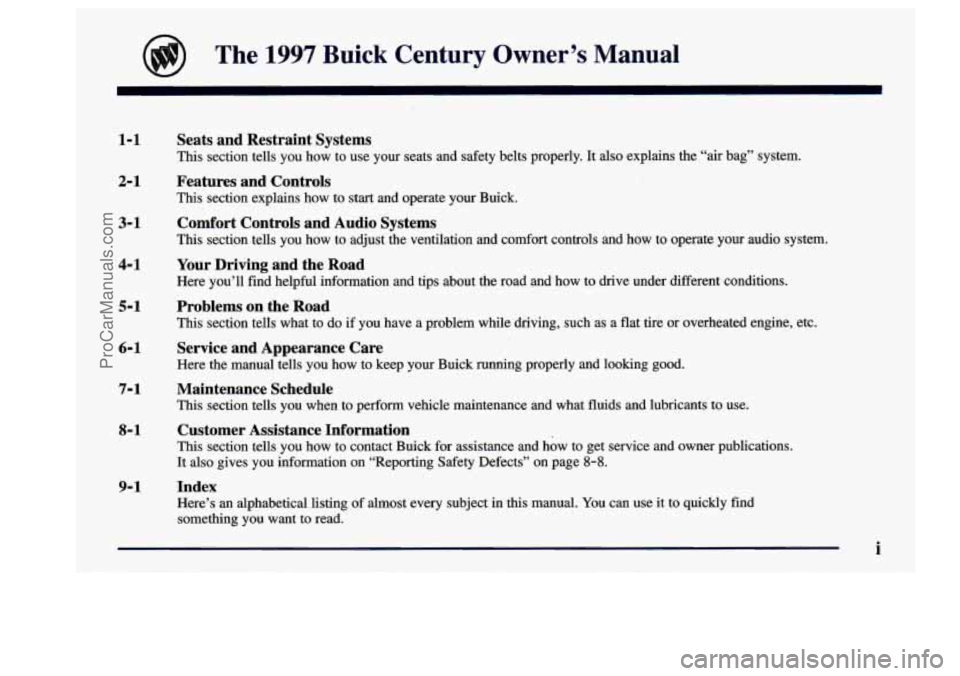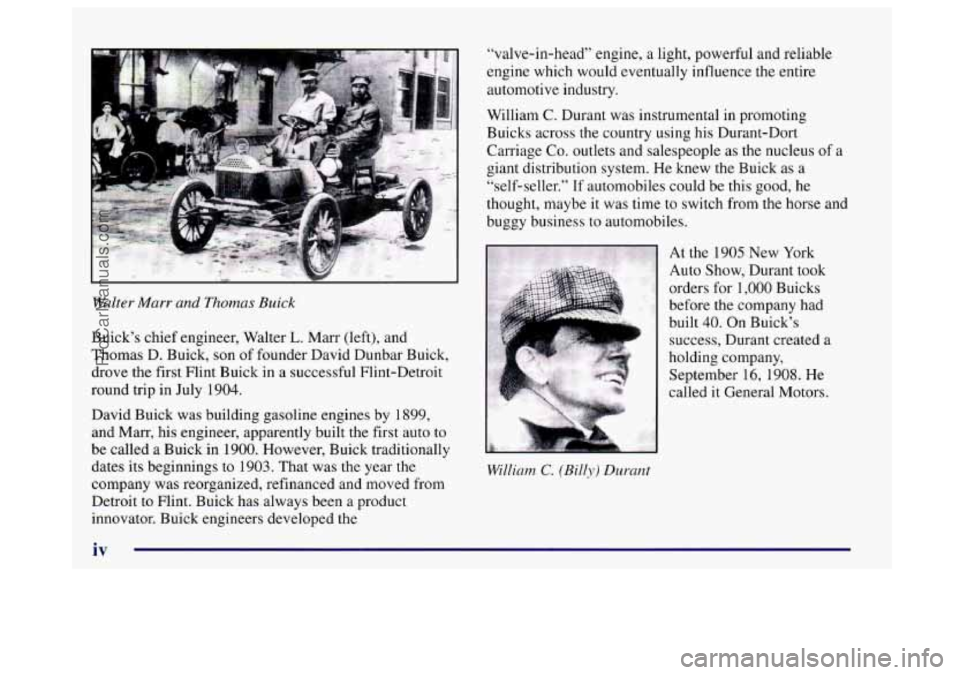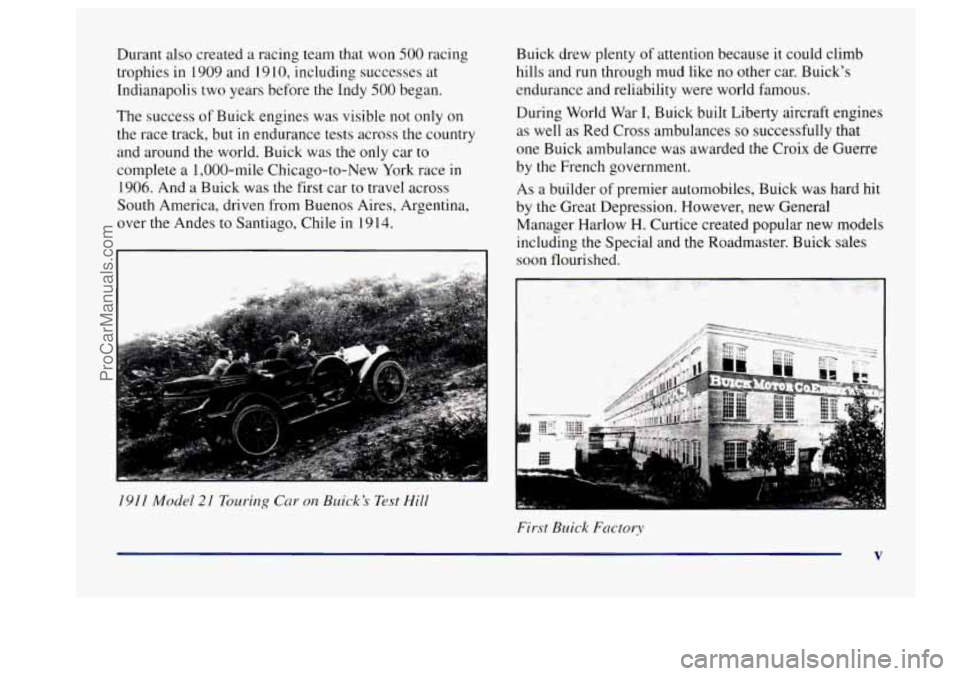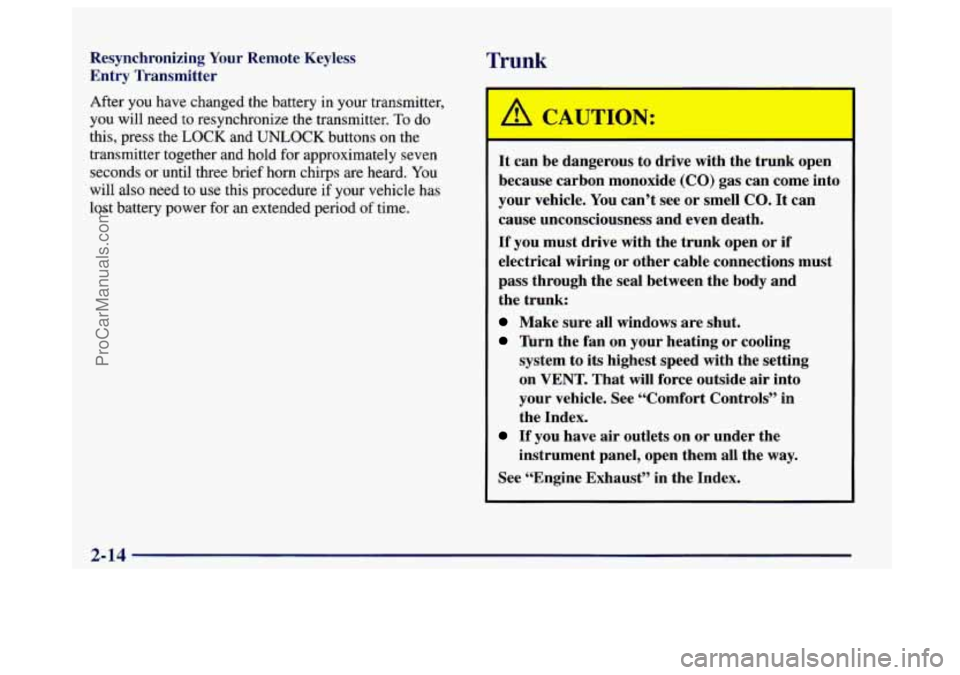Page 3 of 406

The 1997 Buick Century Owner’s Manual
1-1
2- 1
3-1
4-1
5-1
6-1
Seats and Restraint Systems
This section tells you how to use your seats and safety belts\
properly. It also explains the “air bag” system.
Features and Controls
This section explains how to start and operate your Buick.
Comfort Controls and Audio Systems
This section tells you how to adjust the ventilation and comfo\
rt controls and how to operate your audio system.
Your Driving and the Road
Here you’ll find helpful information and tips about the road\
and how to drive under different conditions.
Problems on the Road
This section tells what to do if you have a problem while driving,\
such as a flat tire or overheated engine, etc.
Service and Appearance Care
Here the manual tells you how to keep your Buick running prop\
erly and looking good.
7-1 Maintenance Schedule
This section tells you when to perform vehicle maintenance and what \
fluids and lubricants to use.
8- 1
9-1
Customer Assistance Information
This section tells you how to contact Buick for assistance and how \
to get service and owner publications.
It also gives you information on “Reporting Safety Defects”\
on page 8-8.
Index
Here’s an alphabetical listing of almost every subject in this manual. You can use it to quickly find
something you want to read.
i
ProCarManuals.com
Page 6 of 406

Walter Marr and Thomas Buick
Buick’s chief engineer, Walter L. Marr (left), and
Thomas D. Buick, son of founder David Dunbar Buick,
drove the first Flint Buick in a successful Flint-Detroit
round trip in July 1904.
David Buick was building gasoline engines by 1899,
and Marr, his engineer, apparently built the first auto
to
be called a Buick in 1900. However, Buick traditionally
dates its beginnings to
1903. That was the year the
company was reorganized, refinanced and moved from
Detroit to Flint. Buick has always been a product
innovator. Buick engineers developed the “valve-in-head” engine,
a light, powerful and reliable
engine which would eventually influence the entire
automotive industry.
William
C. Durant was instrumental in promoting
Buicks across the country using his Durant-Dort
Carriage
Co. outlets and salespeople as the nucleus of a
giant distribution system. He knew the Buick as a
“self-seller.” If automobiles could be this good, he
thought, maybe
it was time to switch from the horse and
buggy business
to automobiles.
William C. (Billy) Durant
At the 1905 New York
Auto Show, Durant
took
orders for 1,000 Buicks
before the company had
built
40. On Buick’s
success, Durant created a
holding company,
September
16, 1908. He
called it General Motors.
iv
ProCarManuals.com
Page 7 of 406

Durant also created a racing team that won 500 racing
trophies in 1909 and 1910, including successes at
Indianapolis two years before the Indy
500 began.
The success
of Buick engines was visible not only on
the race track, but
in endurance tests across the country
and around the world. Buick
was the only car to
complete a 1,000-mile Chicago-to-New York race
in
1906. And a Buick was the first car to travel across
South America, driven from Buenos Aires, Argentina,
over the Andes to Santiago, Chile
in 19 14.
Buick drew plenty of attention because it could climb
hills and run through mud like no other car. Buick’s
endurance and reliability were world famous.
During World War
I, Buick built Liberty aircraft engines
as well as Red Cross ambulances so successfully that
one Buick ambulance was awarded the Croix de Guerre
by the French government.
As a builder
of premier automobiles, Buick was hard hit
by the Great Depression. However, new General
Manager Harlow
H. Curtice created popular new models
including the Special and the Roadmaster. Buick sales
soon flourished.
First Bctick Factocy
V
ProCarManuals.com
Page 8 of 406
In World War 11, Buick built aircraft engines, tanks and
other military hardware. This post-war period brought
great styling and engineering changes which resulted in
increased
sales. The torque converter automatic
transmission, Dynaflow, was introduced
in the 1948
Roadmaster. Buick’s famous “portholes” came along
in 1949.
I949 Roadtnaster
A high-compression V-8 engine was introduced in 1953.
And Buick’s famous vertical pillar “toothy” grille
(introduced
in 1942) became more massive in the
post-war era.
... . .
I 953 Sky lark
Motor Trend magazine named the 1962 Buick Special
“Car
of the Year.” The first production V-6 engine was
used in the Special.
vi
ProCarManuals.com
Page 12 of 406
Vehicle Symbols
These are some of the symbols you may find on your vehicle.
For example,
these symbols
are used on an
original battery:
POSSIBLE A
CAUTION
INJURY
PROTECT EYES
BY
SHIELDING
CAUSTIC
BATTERY
CAUSE
BURNS
ACID COULD
&
AVOID
SPARKS
OR
FLAMES
SPARK
OR ,\I/,
COULD FLAME
EXPLODE BATTERY
. K
These symbols
are important
for you and
your passengers
whenever your
vehicle is
driven:
DOOR LOCK
UNLOCK
FASTEN SEAT
BELTS
These symbols have to do with
your lamps:
SIGNALS e
TURN
WARNING
A
HAZARD
FLASHER
RUNNING
' 0
DAYTIME rn
LAMPS .*
FOG LAMPS $0
These symbols
are on some
of
your controls:
WINDSHIELD
WIPER
WINDSHIELD DEFROSTER
WINDOW
DEFOGGER
These symbols are used
on
warning and
indicator lights:
ENGINE t
COOLANT - tm
TEMP -
CHARGING I-1
BATTERY
SYSTEM
BRAKE
(0)
COOLANT a
ENGINE OIL e,
PRESSURE
ANTI-LOCK
(@)
BRAKES
1
Here are some
other symbols
you may see:
FUSE
t
LIGHTER
HORN
)cr
SPEAKER
b
FUEL p3
ProCarManuals.com
Page 13 of 406
I Supplement to the 1997 Buick Regal and Century Owner’s Manuals
This is a correction to information found on page 6-40 (Regal only) and page 6-38 (Century only).
Inflation -- Tire Pressure
The Tire-Loading Information label, which is on the inside of \
the trunk lid shows the correct inflation
pressures for your tires when they’re cold.
“Cold” means your vehicle has been sitting for at least three
hours or driven no more than
1 mile (1.6 km).
This is a correction to information found on page 6-63 (Regal only).
Engine Crankcase
Oil and Filter Change . . . . . . . . . . . . 4.5 quarts (4.2 L)
97RECKEN001
1
ProCarManuals.com
Page 77 of 406

Section 2 Features and Controls
Here you can learn about the many standard and optional features on your Buick, and information on starting, shifting
and braking. Also explained are the instrument panel and the warning systems that tell you
if everything is working
properly
-- and what to do if you have a problem.
2-2
2-4
2-9
2- 14
2-15
2-16 2-17
2-17
2- 19
2-20
3-22
2-26
2-27
2-29
2-30
2-30
2-3 1
Keys
Door Locks
Remote Keyless Entry TrUnk
Theft
PASS-Key@ I1
New Vehicle “Break-In”
Ignition Positions Starting Your Engine
Engine Coolant Heater
Automatic Transaxle Operation
Parking Brake
Shifting Into PARK
(P)
Shifting Out of PARK (P)
Parking Over Things That Burn
Engine Exhaust
Running Your Engine While
You’re Parked 2-32
2-33
2-33
2-34
2-4 1
2-44
2-46
2-49
2-50
2-50
2-5 1.
2-52
2-52
2-53
2-54
2-55 Windows
Horn
Tilt Steering Wheel
Turn SignalMultifunction Lever
Exterior Lamps
Interior Lamps
Mirrors
Storage Compartments
Ashtrays and Lighter
Sun Visors
Auxiliary Power Connection
Sunroof
Cellular Phone Provisions
Instrument Panel
-- Your Information System
Instrument Panel Cluster
Warning Lights, Gages and Indicators
2-1
ProCarManuals.com
Page 90 of 406

Resynchronizing Your Remote Keyless
Entry Transmitter
After you have changed the battery in your transmitter,
you will need
to resynchronize the transmitter. To do
this, press the
LOCK and UNLOCK buttons on the
transmitter together and hold for approximately seven
seconds
or until three brief horn chirps are heard. You
will also need to use
this procedure if your vehicle has
lost battery power for an extended period
of time.
Trunk
It can be dangerous to drive with the trunk open
because carbon monoxide
(CO) gas can come into
your vehicle. You can’t see or smell
CO. It can
cause unconsciousness and even death.
If you must drive with the trunk open or if
electrical wiring or other cable connections must
pass through the seal between the body and
the trunk:
Make sure all windows are shut.
Turn the fan on your heating or cooling
system to
its highest speed with the setting
on VENT. That will force outside air into
your vehicle. See “Comfort Controls” in
the Index.
instrument panel, open them all the way.
If you have air outlets on or under the
See C4Engine Exhaust” in the Index.
2-14
ProCarManuals.com